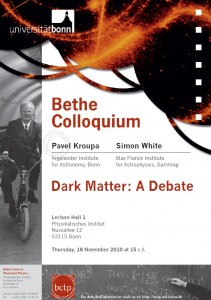Shaking the tree pretty hard

Leaving Leiden
September 24, 2010
A dinner with Tor Norretranders in Stockholm
October 30, 2010Before I start getting done with the re-submission of a paper on the atmospheric transparency above Cerro Paranal, let me share with you the following, which you might find interesting.
You certainly know that one of the key constituents in current cosmology is dark matter, first postulated in 1934 by one of the most prominent astronomers of last century, Fritz Zwicky (this reminds me that my master thesis advisor, prof. Roberto Barbon, was a post-doc of Zwicky, at Caltec). As the name says, this material is, well, dark. So that it cant’ be seen directly. What you can see is its gravitational effects on visible matter (gas, stars, galaxies).So, whenever gravity is playing a role, dark matter would be a fundamental ingredient. And this goes from the rotation of galaxies, to their interaction, to their very formation mechanism. Therefore, an ingredient of paramount importance in the understanding of how and why the universe is what it is.
What is still missing in the picture is the real nature of dark matter. Namely, what it is made of. Maybe the Large Hadron Collider will tell us what it is (you might have heard about WIMPS,a class of massive particles, which would have the property of extremely weak interactions with electromagnetic fields, and so not visible). But so far we do not have a clue. Alternatives to dark matter have been proposed, the most famous being the Modified Newtonian Dynamics, better known as MOND, proposed by Moti Milgrom back in 1983. This has been recently and seriously challenged by the observations of the so called Bullet Cluster. While Dark Matter supporters maintain this is a very strong blow to MOND, MOND supporters have their explanations. All of this just to tell you that the topic is hot, and source of heated discussions.
One of the most authoritative challengers of Dark Matter is prof. Pavel Kroupa (Bonn University, Germany), very famous for his work on the initial mass function of stars. Among other things he maintains a blog on these topics, called The Dark matter Crisis – the rise and fall of a cosmological hypothesis.
Now, in about a month from now, there will be a public debate on this theme in one of the Bethe Colloquiums in Bonn. In this occasion Kroupa will challenge (so to speak) no less a scientist than prof. Simon White, one of the directors of the Max Planck Institute for Astrophysics here in Garching. He is very well known for his work on the formation and structure of the universe (obviously including dark matter, as you may have guessed).
The debate promises to be very interesting. So, if you happen to be in Bonn around November 18th, consider attending it. I have asked prof. Kroupa whether the event will be broadcast live. This is not clear yet, but it will be certainly recorded. If I manage to be present, I’ll give a report on that.
For the time being just a quote. When I was in Leiden for the Supernova conference last September, I discussed with Brian Schmidt about this debate. “Yes” – Brian said – “it is going to be very interesting. Pavel is shaking the tree pretty hard“.
I leave you with that.


